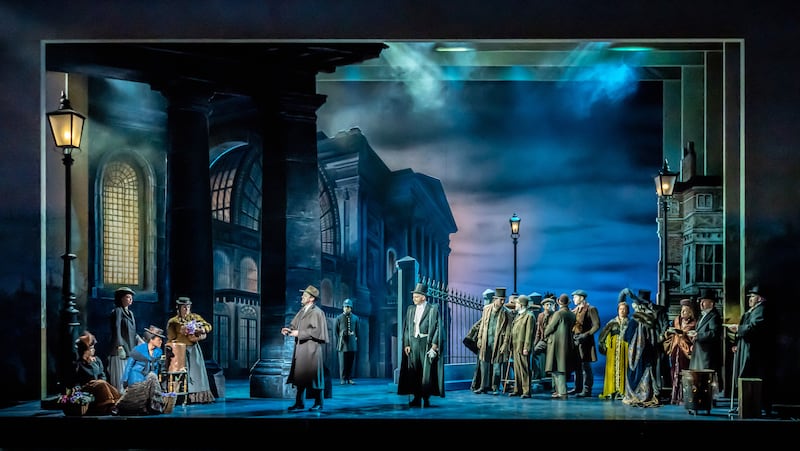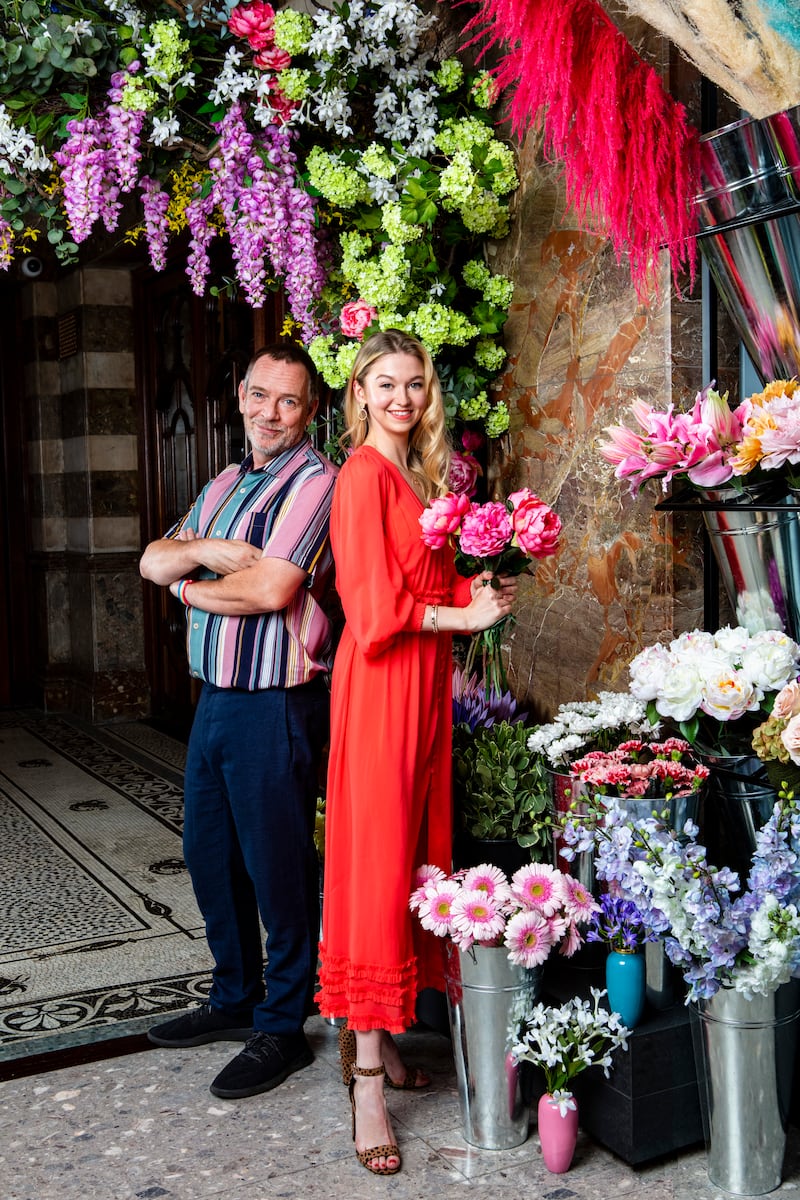“Eliza is a kind of a genius,” says award-winning theatre director Bartlett Sher. He’s talking about cockney flower seller Eliza Doolittle, George Bernard Shaw’s most famous creation, the woman at the centre of his 1913 play Pygmalion, which later became a sumptuous Broadway show starring Julie Andrews and, in 1956, a multi-Oscar winning Hollywood movie musical starring Audrey Hepburn. Described as a “wunderkind” of New York theatre, Sher is the man behind the Tony-nominated revival of the musical four years ago in Manhattan’s Lincoln Centre. All summer it’s been playing in the Coliseum theatre in London’s West End. In October, the story of Eliza’s transformation from “squashed cabbage leaf” to perfectly spoken high-society lady, courtesy of condescending phonetician Prof Henry Higgins, will arrive at the Bord Gáis Energy Theatre in Dublin.
Sher expands on Eliza Doolittle’s genius: “What Higgins didn’t realise to begin with, in his choice of Eliza, was that he had picked someone who was incredibly intelligent when it comes to her ability with language. She’s just extraordinary in how quickly she learns. And you often find that in these great plays by people like Shakespeare, or the great Irish writer Shaw, that characters like Juliet or Eliza are not only brilliant but actually kind of geniuses, much like the writers themselves.”

Shaw’s own genius in carving out Eliza’s story was in exposing issues around feminism, class and sexism in early 1900s Britain, skewering all of it with the kind of biting satire that still manages to resonate more than 100 years later. So much has changed since Shaw first wrote about Eliza — women still could not vote when the play came out — but sit down to watch My Fair Lady now and it’s fascinating to see, in Henry Higgins, the kinds of behaviours and attitudes women still have to contend with, even if there are new names for it: toxic masculinity, gaslighting and — Higgins is a master at this — mansplaining. In today’s world, he’d be cancelled before you could say “wouldn’t it be loverly”. “Why can’t a woman be more like a man?”, he famously despairs in the song Hymn to Him.
For Sher, it was important to go back to Shaw’s original play, Pygmalion, inspired by the Greek myth about the sculptor who, despairing of real-life women, carved a “perfect” woman out of stone. “Shaw was grappling with all these questions ... the position of women, suffrage, the class system.” The ending to the play was hugely important to him, says Sher. “For Shaw it was an impossible thought that Eliza would go back to Higgins at the end. He was completely against the notion of theatre being used to create a false happy ending. So he put a lot of work into what the ending would be. I think he had different problems to what we have now, in that there would have been very few options for Eliza at that time.”
When Shaw wrote the 1938 movie, which won him a best screenplay Oscar, the studio was not happy with the unromantic ending. The ending was changed and, to Shaw’s annoyance, returned to Higgins. “They made the musical based on the movie and preserved the happy ending. I wouldn’t even call it a happy ending, I’d call it a weird ending.”
This reminds me, I tell him, of how when I watched the musical with my 13-year-old daughters recently they were appalled not just by bullying Higgins (Rex Harrison) but by the final scene where Eliza returns to him. In that scene, Higgins puts his feet up, tips his hat over his face and says, “Eliza ... where the devil are my slippers?”, at which point my daughters wanted to throw things at the television, declaring it a “totally stupid, ridiculous” ending.
“Your daughters are right,” he says. “My good fortune was that I got to redo it ... I got to restore Shaw’s ending so it was really clear what was going to happen. That she was out of there. That she was going to leave, that she had her own agency and strength. And I do that because I have two daughters myself and because I am trying to preserve Shaw’s rather brilliant intentions.”

The cast of the touring production, the one on its way to Dublin, will be different from the West End version. For London, Sher cast the first black Eliza, Amara Okereke. “Because she was the best Eliza ... but the very fact of her colour also helps heighten Shaw’s argument about built-in social inequities.” For the touring production, Okereke’s understudy Charlotte Kennedy will take the lead role. “It doesn’t always happen,” says Sher, “but it does happen if you are as special as Charlotte is. She is an extraordinary artist.” The “countercultural” role of Alfred P Doolittle, Eliza’s father, is played by Adam Woodyatt. “In his audition he had a cheeky twinkle perfect for someone like Doolittle, who is not going to follow any rules,” Sher says.
In a tiny room backstage at the Coliseum, Kennedy and Woodyatt are taking a break from rehearsals. Kennedy has already stepped into Eliza’s shoes a few times during this run. Woodyatt, who is on a break from playing Ian Beale in EastEnders, has not been in a musical for decades.
“Life has changed for me in a lot of different ways,” he says. The British tabloids recently reported on his marriage break-up, the fact that he has given up alcohol and his new living arrangements — the actor now lives happily in a motorhome. Taking a hiatus from EastEnders to do a stage play two years ago was rejuvenating. “It took me back to why I fell in love with this job, with acting, in the first place. And coming to this show takes it back even further. The last time I did a musical was across the road from here in 1980, I was in Oliver!” “Were you even born in 1980?”, he asks Kennedy. “No,” laughs the fair haired 28 year old.
Having been understudy to Eliza, “a beast of a role”, Kennedy is thrilled to be taking the lead. “It will never not be lost on me, I’m incredibly grateful for the opportunity. I just want to grab it with both hands,” she says. On the new, restored ending, Kennedy says that “it’s an interesting take, a lot is left to your own assumptions. Eliza decides her future ... what she does is she plays Higgins at his own game. She is clever enough to go her own way.”
I think one of the great functions of what we do in the theatre is return to the past to tell us about the present
Woodyatt’s audition for My Fair Lady was his first in 38 years. Alfred Doolittle is, to put it mildly, fond of a drink. Woodyatt, who once launched a gin brand, gave up alcohol 2½ years ago. He’d had a health issue, unrelated to alcohol, but he says it spurred him on to give up drinking. “It’s one of the best things I’ve done ... alcohol has more negative effects than positive ones. I know this because I used to distill gin ... I just made the decision to stop. It wasn’t problematic, I just thought I would be better off without it and I am.”
He doesn’t know when he’ll be back in EastEnders, or as he calls it “the factory”, but says “Ian Beale will always be part of the fabric of that show. I’m just not there at the moment, but how long that moment lasts I’ve got no idea. If people keep giving me nice jobs like this it could be quite a while.”
As someone well known to the public in another role, has he got something to prove with My Fair Lady? “I’ve got to prove that I can sing and dance,” he laughs. And can he? “Well, we’ll find out. I’ve got stuff to prove to myself because I want to do it and I want to do it well. I want to enjoy myself.” He’s excited about his big number Get Me to the Church on Time — in Sher’s hands an extravaganza of gender bending, sexually liberated mayhem — and about coming to Dublin where he has friends including actor Rory Cowan. “I’ve been texting Rory asking if he has a driveway big enough for me to park my motorhome,” he says. Kennedy, who has played Cosette in Les Miserables, is also looking forward to bringing the show on tour: “It’s just a beautiful piece of work,” she says.

After seeing My Fair Lady in the Coliseum, I can confirm audiences are in for a treat when the production comes to Dublin. It has everything you could hope for. Stunning costumes, soaring voices, gorgeous orchestration and raucous ensemble pieces — the staging of the Ascot scene in particular is sublime. Not forgetting those ravishing songs and lyrics from Frederick Loewe and Alan Jay Lerner: I Could Have Danced All Night, Wouldn’t It Be Loverly, The Rain in Spain and On the Street Where You Live. Best of all, if the happy/weird ending in the 1950s movie musical set Shaw spinning in his grave, this one for the #MeToo era will surely have him cheering.
The ending is not the only new development in Sher’s revival. Walking out of the theatre, it seems one of my Higgins-despising daughters has had a change of heart: “I think I understand Professor Higgins a bit better now. I actually feel sorry for him.” When I tell Sher, he is pleased, saying his approach to Higgins in this revival was deliberately different, placing him somewhere “on the spectrum”. This is more visible in the presentation of the character, rather than any changes to the original text. Loud noises, for example, throw Higgins off. He is very particular about where he puts things and funny about being touched.
“Higgins is incapable of emotional relationships,” Sher explains. “He is focused solely on his work. And he just pursues that relentlessly ... and so the arc we are taking him on is that the relationship with Eliza opens him up emotionally and exposes him to actual love and feelings. And this is something that is quite tragic and hard for him to face. So when you get to the song, I’ve Grown Accustomed to Her Face, you see this man hugely struggling with what he feels and who he is.”
I ask Sher about the post-pandemic theatre landscape. He doesn’t believe audiences are “fully back” yet and says the challenge for theatre-makers is “to make work that will bring them back”.
So why should audiences go to see My Fair Lady? “I think one of the great functions of what we do in the theatre is return to the past to tell us about the present,” says Sher. “My Fair Lady is one of our great stories ... the pure experience of going back in time and seeing a show like My Fair Lady and asking what it was like for a woman at that time. And then boom, being a 13-year-old girl and going, ‘well, where am I going? What am I going to do with my life? Today. Now?’ Those are all the ways in which theatre can intersect with your life, and help you look at the past and help you think about the future. It’s almost therapeutic.”
My Fair Lady is at the Bord Gáis Energy Theatre from October 6th to 20th


















